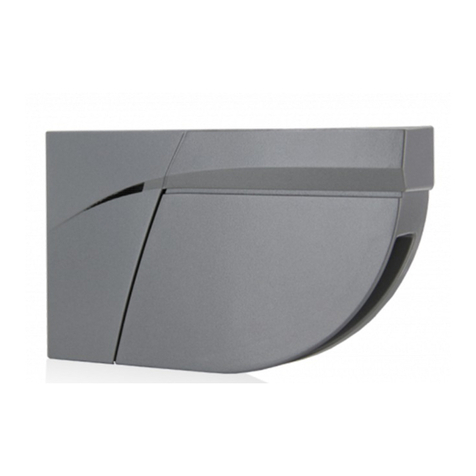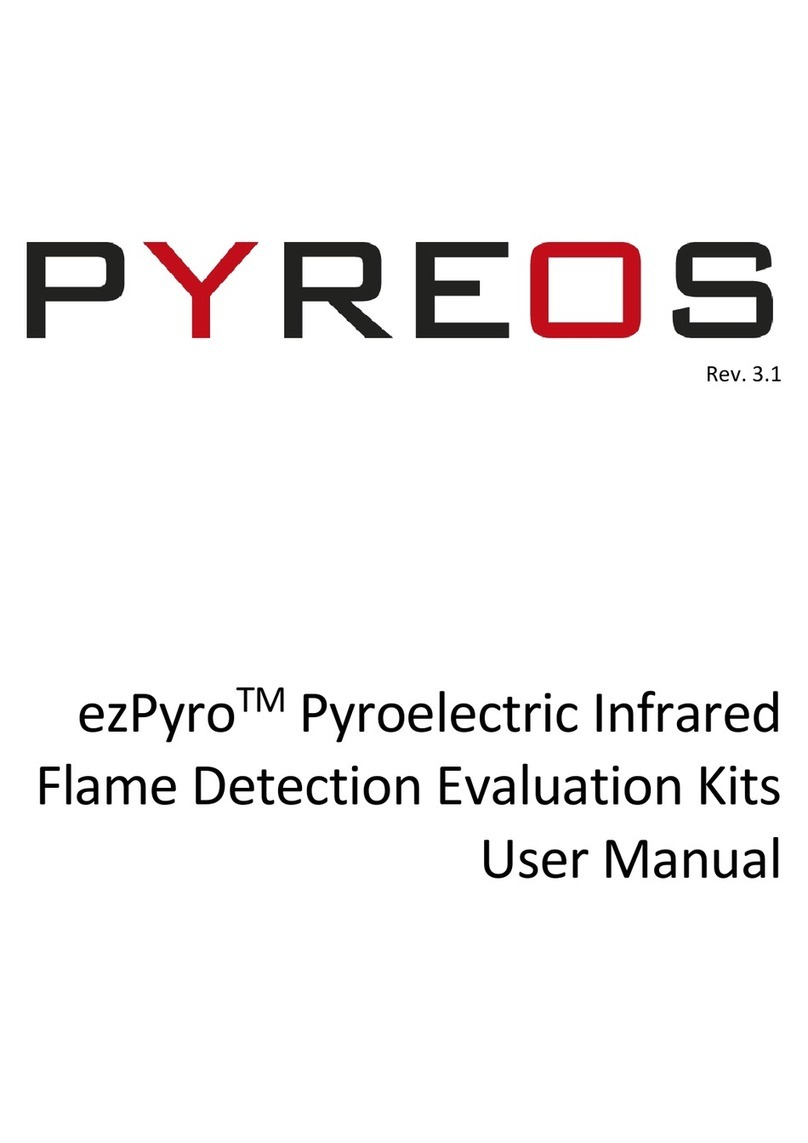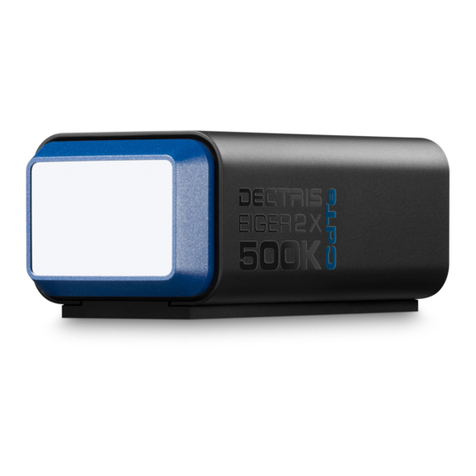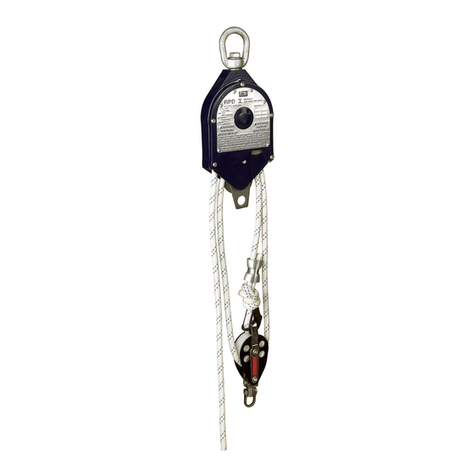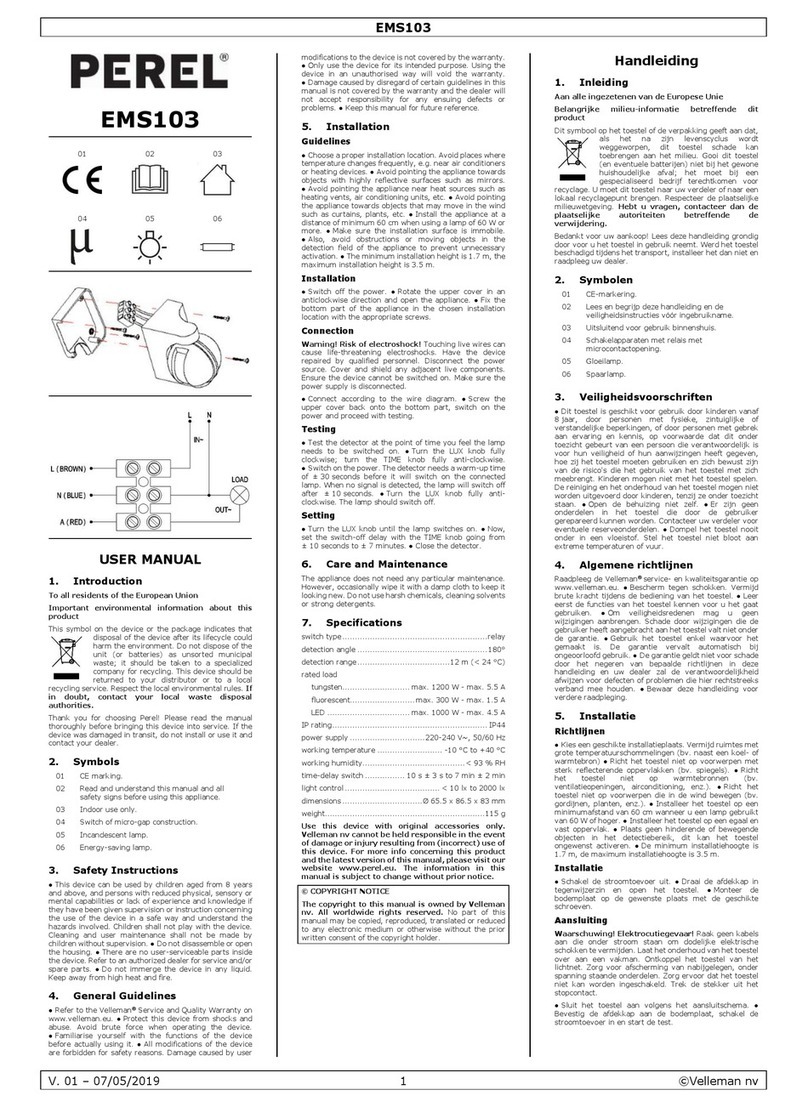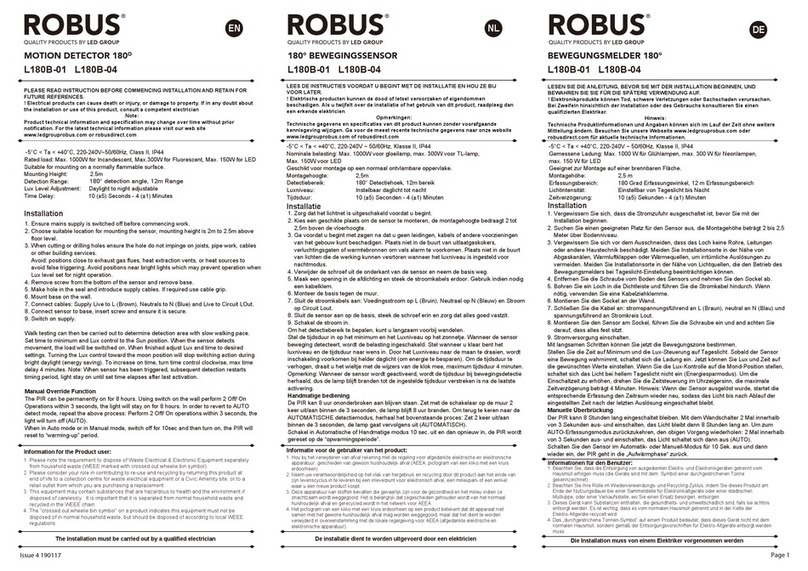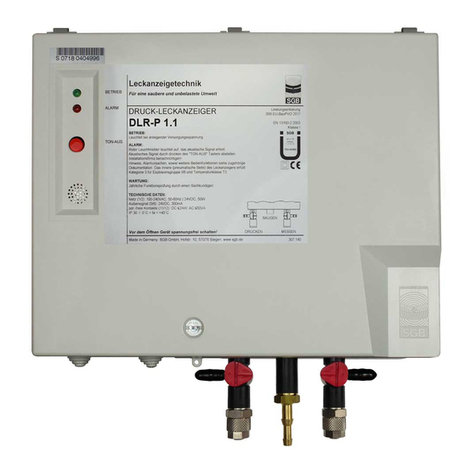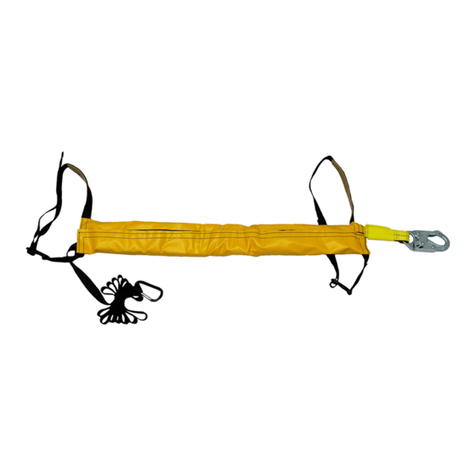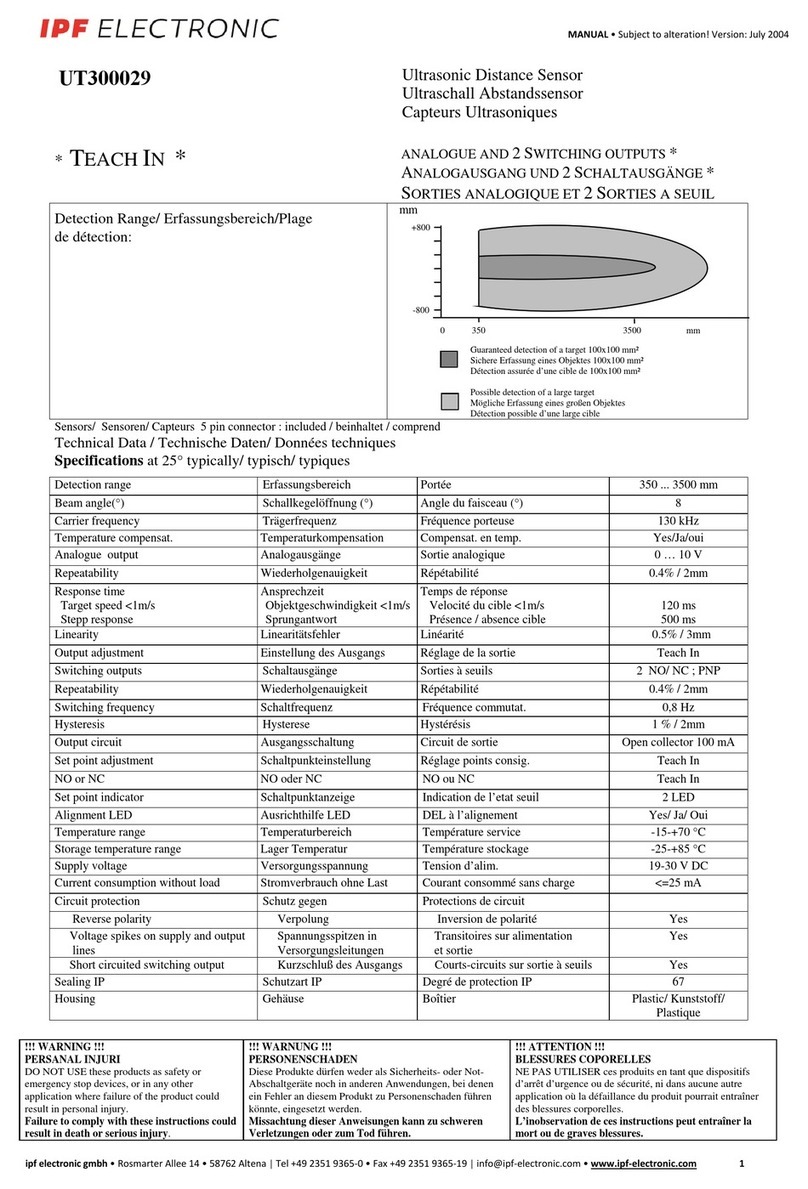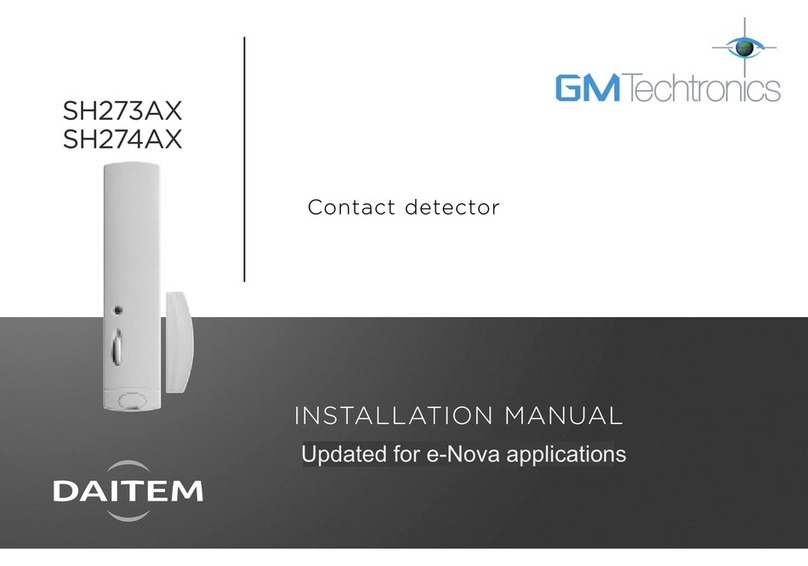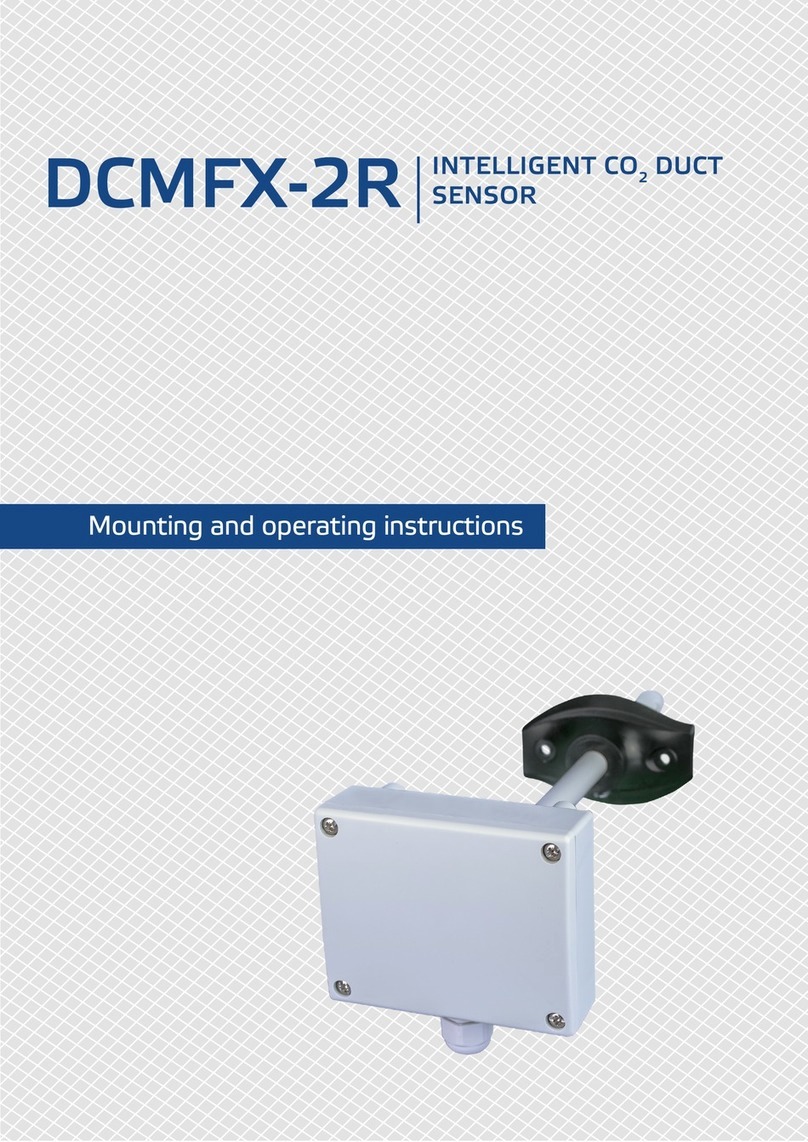MPH Industries SpeedLaser B User manual

USER'S MANUAL
PLEASE SEE BACK COVER FOR CONTACT
INFORMATION REGARDING REPAIRS AND
SALES
P/N 40150-66-MPH
(For Version 6.70 and above)
Disclaimer: The information contained here is accurate and reliable to the best of our knowledge at time of printing and is subject
to change without notice. No responsibility is assumed by MPH Industries for use of this information. MPH Industries, its logo,
Laser Atlanta, its logo and Advantage™, ProFiler™, SmartCharger, SpeedProof™, wiDAR™, SmartAdaptor™ & SpeedLaser®
are trademarks of MPH Industries, Inc. All other trademarks are the property of their respective companies. Patent Numbers
6,108,071; 7,286,955; 7,493,086 © 2012 MPH Industries, Inc. All rights reserved.


TABLE OF CONTENTS
1 INTRODUCTION......................................................................5
Cautions:..........................................................................6
Capabilities ......................................................................7
2 GETTING STARTED.................................................................9
Packing List .....................................................................9
SpeedLaser®Controls & Layout ....................................10
Battery Handle Power....................................................12
Connecting a Handle .....................................................13
To Power ON.................................................................14
To Power OFF................................................................14
3 SPEED MEASUREMENT ........................................................ 15
Speed Detection .............................................................15
Approaching and Receding Targets ..............................15
Approaching and Receding Targets ..............................16
Manufacturer’s Recommended Daily Test.....................17
4 USER SETTINGS ........................................................................... 21
Intensity and Contrast ...................................................21
LCD Backlight................................................................21
LCD Contrast.................................................................21
HUD Brightness.............................................................21
The MENU System ........................................................22
Main Menu ....................................................................25
Test Mode ......................................................................26
Audio.............................................................................27
HUD Mode ....................................................................28
AIMING MENU ............................................................29
Obstructed Mode ...........................................................32
5 APPENDICES................................................................................. 33
Do not copy 3

Appendices: Page #
A: Troubleshooting / Error Messages 33
B:CareandMaintenance 34
C: SpeedLaser® and Accessory Diagrams 36
D: Measuring Surface Datum 37
E:LIDARMenuTree 39
Warranty 38
Do not copy 4

CHAPTER 1 Introduction
Thank you for purchasing the SpeedLaser®. This rugged laser speed
detection device integrates the latest in solid-state laser technologies to
bring you hand-held, eye-safe laser speed and distance measurement.
The SpeedLaser®is a Class 1 eye safe, multi-function device generally
used to calculate range and speed of targets at a distance. Depending on
reflective characteristics of the targets, the environment and other
factors, distance may vary.
The technology utilized by the SpeedLaser®is called LIDAR: LIght
Detection And Ranging. Your SpeedLaser®measures the time it takes a
pulse of laser light to travel from the LIDAR to the target vehicle and
back (pulsed time-of-flight). This round trip time is converted to a
distance (d=ct/2). The distance to the target vehicle is calculated in this
manner over two hundred times per second. Sophisticated computer
algorithms combine these individual range calculations to compute the
extremely accurate speed displayed. The IACP lists this device on their
product list (CPL) after testing to their specifications.
To get the most from your new SpeedLaser®, please take the time to read
through this manual. For your convenience and ease of understanding,
it has been divided into 5 sections:
Chapter 1: Introduction
Chapter 2: Getting Started
Chapter 3: Speed Measurement
Chapter 4: User Setting’s
Appendices: Information on care, troubleshooting, and
specifications
If you have questions or comments, please do not hesitate to contact us.
PLEASE SEE BACK COVER FOR CONTACT
INFORMATION REGARDING REPAIRS AND SALES
Do not copy 5

Cautions:
Every step has been taken to ensure your SpeedLaser®is completely safe to use.
However, certain common-sense precautions should always be taken when using
your SpeedLaser®.
•Do not open the LIDAR unit’s housing under any circumstances.
•Do not point the SpeedLaser® directly at the sun.
•Use only MPH Industries approved power sources and accessories.
(use of unauthorized accessories may void the warranty)
•Do not store SpeedLaser®in areas of high humidity.
•Do not place SpeedLaser®on unstable surfaces.
•Always transport the SpeedLaser®in its carrying case.
SpeedLaser®is a Class 1 Laser Product which does not exceed a PRF of 240Hz,
a Pulse Width of 100 nsec nor a laser power of 238 uWatts, and has a Class 1
Laser Product label in the serial number window (see index D on the Layout
Figures found on pages 11 & 12).
Caution: The use of controls or adjustments or performance of procedures
other than those specified herein may result in hazardous radiation
exposure.
Any certifications included are void if the product is opened, altered, installed in
other equipment or used for purposes other then intended by the manufacturer.
Using any charger other than those supplied by MPH Industries will also void
the certification.
Although optical viewing instruments may increase eye hazard, it is unlikely
that actual damage can occur. Prescription eyeglasses, contact lenses, and
sunglasses are not considered optical gain devices since they merely correct the
focus of the human eye to normal.
Optical devices that provide magnification may increase the risk of eye-hazard.
These include binoculars, telescopes and magnifying glasses.
Certain municipalities and countries require settings to differing measurements
(mph or km/h). Your unit is factory set to the appropriate unit of measurement.
The pictures/drawings/illustrations in this manual are for illustration only and
are shown in miles per hour and feet as well as kilometers per hour and meters.
Do not copy 6

Capabilities
Performance
•Target Acquisition in 0.3 seconds
(Dependent on environment and reflective characteristics of target)
•Speed Accuracy of one unit of measure
Advanced Input-Output
•Remote Fire trigger switch
•Full Remote control via RS-232 port
•Data Collection via RS-232 port
Ease of Use
•Menu Driven
•Head Up Display (HUD) shows both target and speed or distance
data through the same sighting mechanism
•Optional Rechargeable NiMH or 9 volt Battery Handle
•Optional 12 Volt Cigarette Adapter
•Optional 8X Monocular (S & R only)
•Optional Monopole (S & R only) and Tripod for mounting
•Optional Mapping system upgrade (S & R only)
•Optional USB/SD Memory Drive
Environmental Features
•Water Resistant (R = IP67, optional for B & S which are IP56)
•Ruggedized Housing
•Rechargeable NiMH Battery Handles (S & R only, B batteries
are NiMH internal)
Do not copy 7

Optional accessories, carrying
cases and cords in a variety of
styles are available.
All four models of the SpeedLaser® use the same display and
user interface. The four different keypads are shown below. Any
feature or function shown on one display or key board is available
on all models. The menu tree described through out this manual
is used with all of the key pads:
Do not copy 8

Chapter 2
Getting Started
PACKING LIST
Please check to make sure the following items that were ordered are
included in your shipment, such as:
•SpeedLaser®LIDAR Unit
•Battery Handle (S, T & R only; optional on B)
•Carrying Case
•Battery Charger (if applicable)
•12 volt Charging Cable (if applicable)
•User's Manual
Additionally, you may have received the following optional parts:
•RS-232 Serial Data Cable
•8X Monocular
•Additional Battery Handles
•Additional optional charging cords and accessories
(Please see Appendix C for diagrams of some of these items.)
Do not copy 9

SpeedLaser®Controls & Layout
(Typical – wording may vary in different versions.
Drawings are for illustration only.)
B
A
G
FIRE
BACK
←
POWER
LCD
MENU
HUD
LASER
A
TLANTA LLC S/N: 23456
NORCROSS, GA 30071 Class 1 Laser Produc
t
B C D
H
D
F
E
ENTER
A
C
A: Head Up Display (HUD) E: Liquid Crystal Display (LCD)
B: HUD Sighting Reticle F: Keypad Keys
C: HUD Character Display G: Rear Bumper (R model only)
D: Serial #, Laser Warning H: Optional Memory Drive Slot
Do not copy 10

I J
I: Transmit Optics M: Battery Handle (most models)
J: Receive Optics N: External Data/Charging Port
K: Handle Trigger (Tripod mountable handle
L: Handle Latch has data port on the side)
O: Laser Warnings (Alternate
Location Select Models Only)
Do not copy 11

Battery Handle Power
The SpeedLaser® may come equipped with a rechargeable battery handle
shipped uncharged (B batteries are internal). You may need to charge it
completely (10-12 hours) with the wall charger or 12 Volt cigarette cable
before first use. Each handle provides an average of 8 hours or more of
continuous use per charge (hours vary based on use and conditions).
These handles, and the B model with internal batteries, are also capable
of powering the SpeedLaser from a 12V source such as an automotive
cigarette power adapter using the cable if provided. Plug the small
circular connector onto the Charging Connector on the side of the handle
and the cigarette adapter end into an automotive cigarette-power adapter.
You can charge the handles in this manner while operating the unit. A
Power Handle connected to a B will charge the internal batteries. While
the 9v handle can be used with the B it is not efficient.
To charge your battery:
1. Plug the circular connector into the Charging Connector on the
side of the handle or bottom of B. Do not force the connector as
it is keyed...slowly rotate the connector (holding the black
rubber) and push gently until it clicks and locks into place.
2. Plug the charger into a standard 120 VAC power receptacle OR
plug the cigarette adapter into a power source.
3. Charge the batteries for ten to twelve hours.
4. To remove the connector, pull gently away from the handle on
the outside of the metal connector.
5. Unplug the charger from the wall. The batteries are charged.
CAUTION! DO NOT:
•Charge batteries with chargers not supplied by MPH Industries.
•Short circuit the battery pins
•Charge batteries for over sixteen (16) hours continuously
Do not copy 12
Green Charging Light
Charging Connector

Connecting a Handle
(All Models and B models equipped with handle mount)
To install a handle onto the SpeedLaser®:
1. Press the Handle Latch forward on the handle.
2. Push the front of the handle into the front Handle Catch on the
bottom of the SpeedLaser®.
3. Rotate the rear of the handle upward.
4. Release the handle latch.
NOTE: Make certain the handle latch slides into position and secures the
handle to the SpeedLaser®. If necessary, push the handle latch toward the
back to secure the handle to the SpeedLaser®.
Do not copy 13

Turning the SpeedLaser®ON and OFF
TO POWER ON
1) Press and hold the PWR key located on the back of the
SpeedLaser® for approximately one second.
NOTE: The hardware and software Built In Test (BIT) automatically
runs when the unit is first powered ON. When BIT is completed
successfully the LCD will display “SYSTEM READY.” or
“Self-Test Passed”. Either indicates that the BIT has been completed
successfully.
TO POWER OFF
1) Press and HOLD the PWR key on the back of the
SpeedLaser® (see note) for approximately three seconds.
NOTE: Keep the key pressed until “POWERING DOWN” is displayed
on the LCD then release the keypad. If the button is not depressed for a
long enough time, it toggles the LCD backlight ON and OFF.
Laser Atlanta
SpeedLaser
P/N YYYYY-EEEE vx.xx
SYSTEM READY.
LCD HUD
A B C D
FIRE
PWR MENUBACK
Power Key
Do not copy 14

Chapter 3
Speed Measurement
When the SpeedLaser®is first turned ON, it automatically and quickly runs the
Built In Test (BIT) functions. To capture a speed, simply follow the procedure
below when the BIT is complete.
SPEED DETECTION
NOTE: Always verify operational procedures for Alignment Check.
1. Align the HUD Sighting Reticule (+ symbol in the HUD) on the target
you wish to measure the speed of.
2. Squeeze and hold the Handle Trigger (on B press the fire button on top)
until the speed is displayed.
3. Release the Handle Trigger (or fire button) to stop measurement,
momentarily display the information in the HUD and lock information
on the LCD. The LCD displays the information until one of the
following occurs:
a.) The laser is fired.
b.) The unit is powered down (by the operator or typically after
about 10 minutes of inactivity) or
c.) The menu button is pressed.
The speed will be shown in three places…twice on the rear right of the LCD and
also momentarily in the HUD (when selected) character display. Notice that two
of the speed displays are truncated to the nearest mph or km/h.
The distance to the target will be shown on the left side of the LCD.
- 13
HUD
S
p
eed
NOTE: Pressing the trigger/fire button will take you to the Speed Display Page
regardless of any other mode the SpeedLaser® may be in. (The exception is
when in the TEST mode.)
LCD
Range
Display
Do not copy LCD
Speed
Display
15

APPROACHING AND RECEDING TARGETS
The SpeedLaser®can measure the speeds of both approaching
(oncoming) and receding targets.
When the target is receding, a “-” sign will precede the speed displayed
in the HUD and on the LCD.
Example of an Approaching target
Oncoming
Target
(No “-“ sign)
Example of a Receding target
-13
Recedin
g
Target
Receding
Target
(“-“ sign)
Do not copy 16
Oncomin
g
Target
34

Manufacturer’s Recommended Daily Test
In keeping with NHTSA (National Highway Traffic Safety
Administration) and IADLEST (The International Association of
Directors of Law Enforcement Standards and Training) guidelines
general operational considerations for LIDAR Speed Measurement
devices, the operator must perform the following accuracy checks prior
to beginning enforcement operations:
1) Internal Circuit Check
2) LED Segment Test
3) Range (Chronometer) Accuracy Test
4) Horizontal Sight Alignment Test
5) Vertical Sight Alignment Test
WHAT THE DAILY TEST ACCOMPLISHES:
To ensure that the SpeedLaser®is in good working order, the
SpeedLaser® should be tested using the Manufacture’s daily test
described later in this chapter. This test restores the factory default
settings, checks the LIDAR hardware (including the program and
dynamic memories), tests the displays and timing circuits, and then
allows the operator to verify that the HUD aiming crosshairs are
correctly aligned with the laser beam.
NOTE: The alignment crosshairs in the HUD are set at the factory and
generally do not need realignment over the life of the SpeedLaser®.
1) Internal Circuit Check
When the operator presses Menu, followed by Test, (button A on the
keypad), the SpeedLaser® runs a BIT (Built-In-Test) program. The
BIT program tests the hardware and software by verifying that the
SpeedLaser® firmware is loaded correctly and then checking that the
processor is executing the data gathering, storing (memory), sorting,
filtering, conversion and linear regression algorithms correctly.
2) HUD’s LED Segment Test
This test allows the operator to verify that the seven-segment display,
used to show speed of the target vehicle, is in good working order by
displaying a simple known pattern. The operator can then confirm that
each segment operates correctly and verify the presence of the aiming
reticle.
3) Range (Chronometer) Accuracy Test
Do not copy 17

The SpeedLaser®hardware ONLY measures Time. Range and
Speed are computed values derived from multiple time
measurements by the firmware, which was checked for proper
operation during BIT. The design and accuracy of the firmware was
verified as part of the IACP certification and subsequent testing
processes.
This test uses the SpeedLaser®’s high-speed chronometer (timer) to
measure the time it takes a light pulse to travel a known distance
(i.e.; from the SpeedLaser® to a target at a known distance and back).
Since the speed of light in air is known, the SpeedLaser®can
calculate the range that the light pulse traveled. The operator then
compares the reported range to the known distance to the target. To
verify that the timing hardware is working correctly the computed
range must match the known distance to within ±1 foot (30 cm). At
least two such comparisons using targets at least twenty (20) feet (6
meters) apart must be made.
In normal operation, the SpeedLaser® measures the time it takes for a
light pulse to travel from the SpeedLaser®to a moving vehicle and
back. The SpeedLaser® makes hundreds of such round trip time
measurements each second, each time measurement is converted to a
range and stored. When the SpeedLaser®has sufficient stored
ranges, it performs a linear regression calculation that yields the
speed of the vehicle. Numerous firmware filters are used to confirm
the computed speed before it is displayed.
4) Horizontal Sight Alignment Test
This is a test to confirm that the sighting system and the invisible
light pulse emitted by the SpeedLaser® are aligned horizontally. The
operator uses the sighting system to aim at an object and then
confirms that the light pulses of the SpeedLaser®are hitting that
object by observing that the SpeedLaser®is reporting the range to
that object. The operator then moves the sighting system off of the
object and observes that the reported range changes, just as the
sighting system is no longer on the object and indeed should change.
5) Vertical Sight Alignment Test
Same as Horizontal alignment test but in the vertical axis
Do not copy 18

When the SpeedLaser is initially powered ON, it automatically and very quickly
runs a hardware and software Built In Test (BIT). When successfully
completed, the LCD screen will display “SYSTEM READY” or “Self Test
Passed”. You are now ready to complete the following recommended daily
tests, listed as #1 through #5, prior to conducting any enforcement activity.
Running the Manufacturer’s Recommended Daily Tests
1) Internal Circuit Check
Press MENU followed by “A” on the keypad, which selects Test.
The LIDAR will then automatically:
a) Enter the RESET & TEST Mode
b) Restore factory default settings
c) Run the hardware Built In Test (BIT)
d) Run the software BIT including dynamic memory test
e) Runs an LED count test (1111, 2222, …, 9999)
f) Defaults the HUD display to .8.8.8.8
Wait for “TEST PASS” or “Memory-OK” to be displayed. Either
indicates that steps a to d have been completed successfully.
2) Light Segment Test
Confirm e or f, the HUD is displaying aiming “+” with the data “.8.8.8.8”.
3) Range (Chronometer) Accuracy Test
Confirm that the LIDAR can correctly compute two or more known ranges
using any one of the following methods:
a) From one location, range to two targets at known distances.
b) From two locations, range to one target at a known distance.
c) Range to a random target, back up a known ‘delta’ distance, and
confirm that LIDAR computes a new range with the same delta
distance. Then back up a second, but different delta distance and
confirm that LIDAR computes a new range that matches the new
delta range.
d) Combine method a) with the horizontal and vertical alignment tests
(4 and 5) on next page. This requires that the targets used for the
Horizontal and Vertical alignment are at different known ranges.
Using your preferred method from above:
a) Stand at the selected position.
b) Aim at selected target.
c) Squeeze and hold trigger/fire button until tone sounds (range is
computed).
d) Confirm that reported range is within ±1 foot (30 cm) of expected.
e) Repeat steps a) thru d) using a known distance that is at least
20 feet (6 meters) different than the first known distance.
Do not copy 19

4) Horizontal Sight Alignment Test
a) Locate a vertical object (such as a utility pole) with open sky
behind, preferably at a distance greater then 150 feet/45 meters.
b) Aim to the left or right of the object, pull and hold the trigger/fire
button.
c) While keeping the trigger/fire button pulled, slowly sweep the
crosshair sight across the vertical object.
d) The distance to the pole should be displayed once the target edge
is inside the HUD crosshair.
e) Press D (Done/Next) to display next step.
5) Vertical Sight Alignment Test
a) Turn the unit 90 degrees sideways and repeat steps 4) a – e.
b) Press MENU or DONE to exit Test Mode.
Note: If desirable, the horizontal and vertical alignment tests may be
conducted using an horizontal object, such as a utility wire, with
open sky. However, it will be necessary to turn the Lidar unit 90
degrees to conduct the horizontal test and return it to the upright
position when testing the vertical axis or plane.
Sweep from
the RIGHT
Sweep from
the LEFT
Do not copy 20
This manual suits for next models
3
Table of contents
Popular Security Sensor manuals by other brands
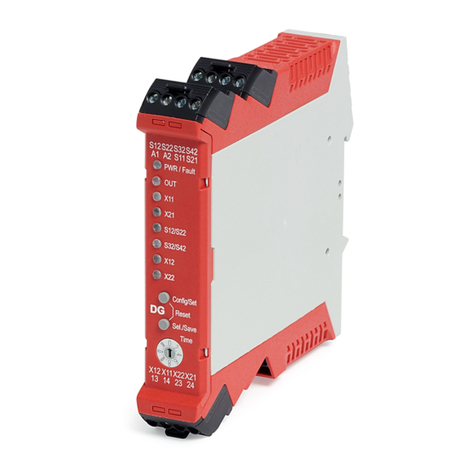
Allen-Bradley
Allen-Bradley Guardmaster GuardLink user manual
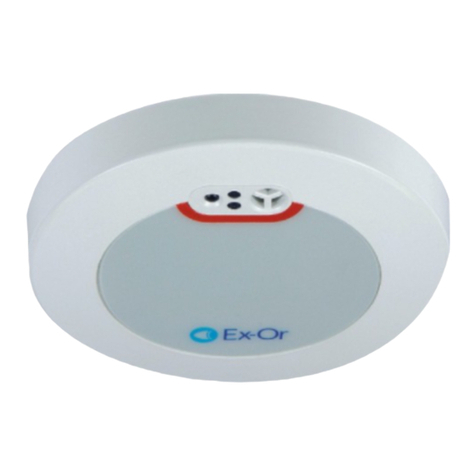
Honeywell
Honeywell Ex-Or Digital Gold Series Installation and commissioning instructions
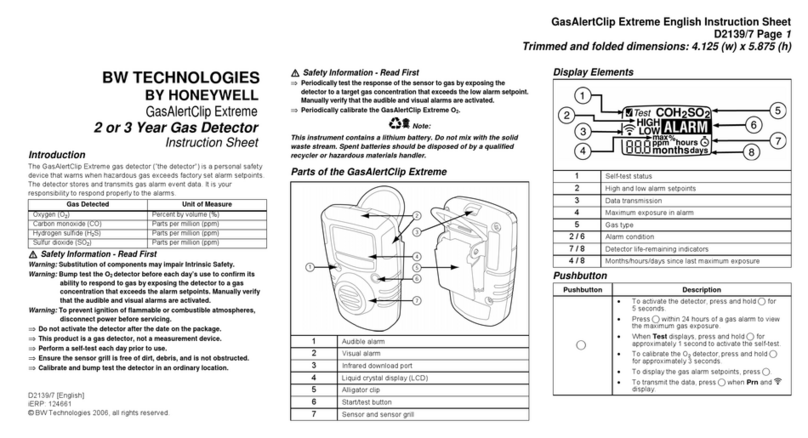
BW Technologies
BW Technologies GasAlertClip Extreme SO2 instruction sheet
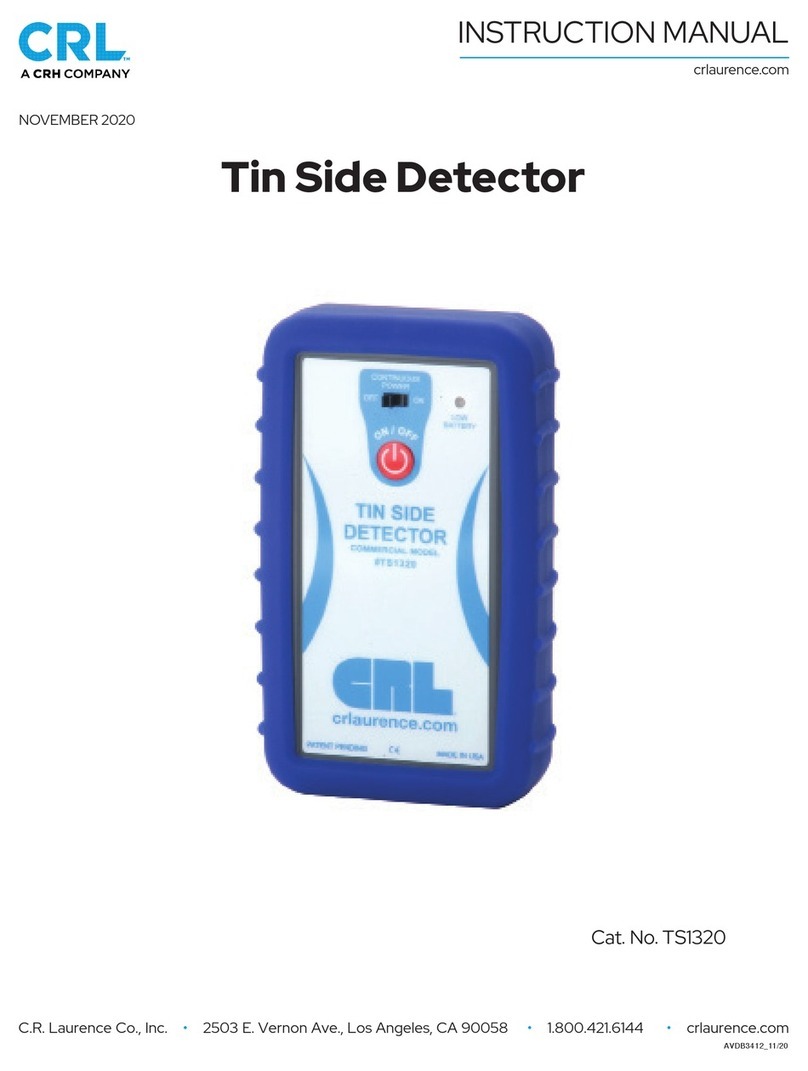
CRH
CRH CRLTS1320 instruction manual
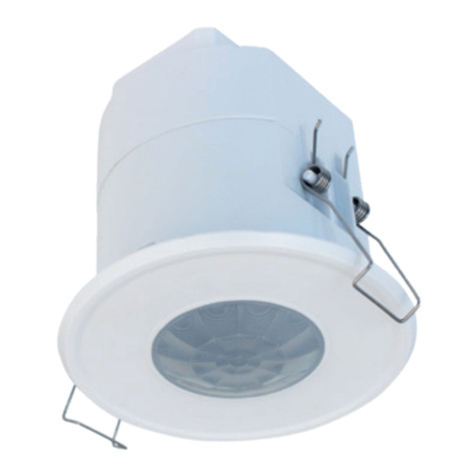
Hytronik
Hytronik HIR27 manual
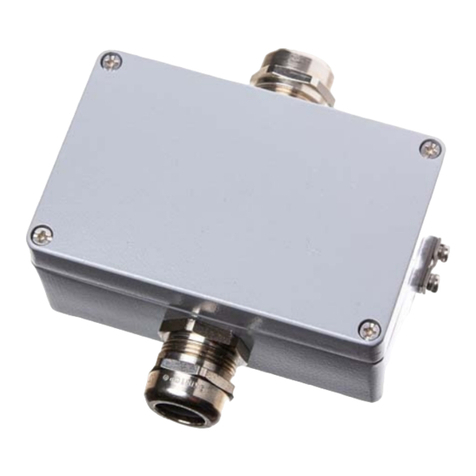
Evikon
Evikon PluraSens E2658-VOC user manual
